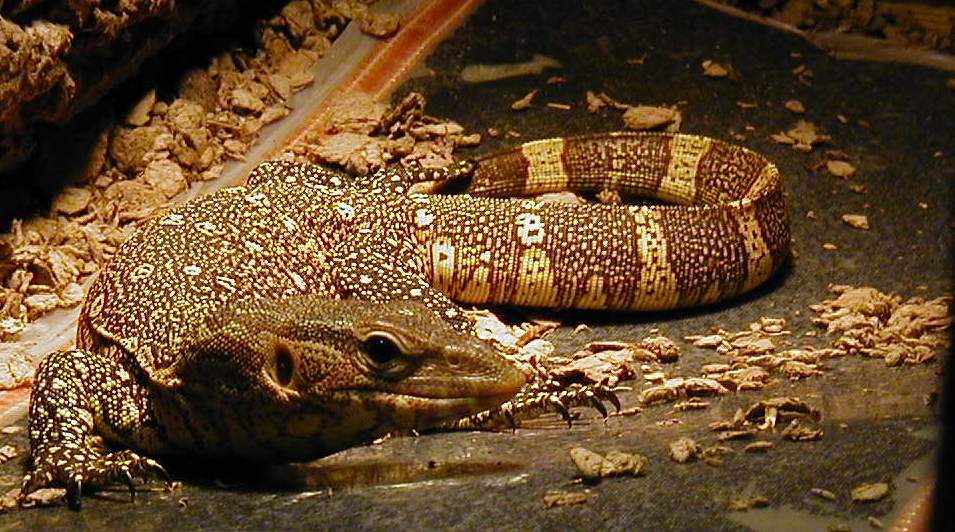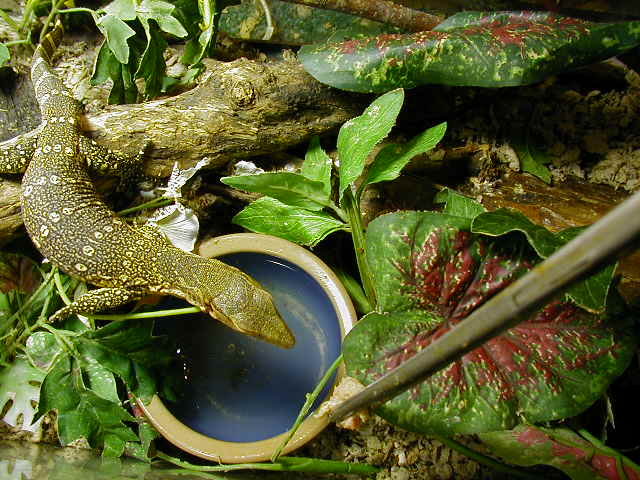

Ornate monitors are a species little known to science, yet well established in the pet trade. They are an African forest monitor, living in the impenetrable deepness of the Congo rain forest of Western Africa. Until recently, they had been considered a subspecies of the Nile monitor, resulting in much confusion. It is obvious to anyone who has worked with both varieties, however, that they are very different animals. I have written a web page here explaining the difference.
Although no studies have been done on the ornate monitor in the wild, they are probably a typical semi-aquatic large monitor in many ways. They are predators and scavengers, eagerly eating most any source of food that is vaguely meat-like, from rats and snakes to crabs, insects, and clams. The head of the ornate monitor is among the most powerful and robust of any monitor species, they undoubtedly use their jaws like nutcrackers to break open snails, clams, and crabs for the meat inside. Like all monitors, they love eggs, and will crack eggs in their jaws, hold their head up, and let the juices dribble down their throats.
Ornate monitors take readily to water, they are probably semi-aquatic in lifestyle, living close to streams, ponds, lakes, and river banks in their jungle home. They are also good climbers, diggers, and runners, however, and by no means confined to a watery existence.

The ornate monitor is a stout beast, with powerful, robust proportions. They have a massive triangular head with a distinctly bowed lower jaw. The neck is long (although not as proportionaly long as that of many other monitors) with a distendable throat pouch; when not distended, the skin of the throat pouch hangs in folds about the neck and throat. The stocky, muscular limbs have long digits tipped with large talons. The tail is long, thick and muscular near the base, tapering to a whiplash at the end, and keeled along most of its length. Their markings are similar to that of the Nile monitor, although their patterns are uniformly bigger and bolder than the delicate patterns of their slenderer cousins. Their base color is typically grey or grey-brown with yellow or cream spots. The limbs are marked with spots; hash marks extending across the upper and lower jaws obscure the opening of the mouth; a dark stripe goes through the eye and merges with a series of chevrons marching down the neck, which subsequently break up into spots crossing the back in distinct bands, which then merge into solid rigs encricling the tail. The throat and sides are marked with distinct reticulations, and narrow dark lines cross a light colored belly. The tongue is long, narrow, forked, and pink in color. The adult size of this animal can range from a little less than a meter to up to two and a half meters.

As pets, my experience is that ornate monitors are more trusting of their human captors than Nile monitors, some become quite docile. Still, not all animals of this species are friendly by any means, some will remain aloof or untrusting despite gentle treatment. Compared to their behavior towards humans, their relationships between themselves seem more antagonistic than those of most monitors. Those I have kept, at least, seem to be born bullies. They harrass and cruelly dominate those that are smaller than themselves, often employing bites to the head. How they can reproduce with an attitude like this, I am not sure. Maybe mine are atypical; maybe mine have all, by coincidence, been the same sex.
The care of ornate monitors is practically identical to that of the argus monitors. Ornates are, however, better equipped for dealing with hard shelled prey, such as snails and crayfish, although these are not neccessary in their diet. Ornates do not dig quite so enthusiastically as arguses, although they do like to dig their own burrow and a deep dirt substrate that holds a burrow is still the best choice.
